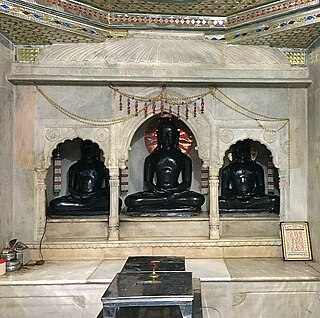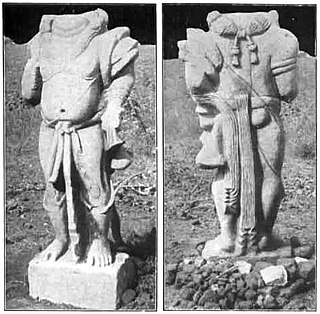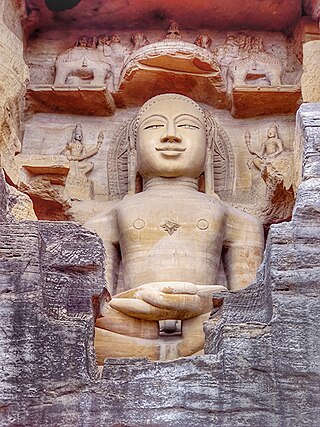
Bundelkhand, a region in central India, has been an ancient center of Jainism. It covers northern part of Madhya Pradesh and southern western part of Uttar Pradesh.
Shah is a common surname in India, Nepal, Bangladesh and Pakistan.
Kashtha Sangha was a Digambar Jain monastic order once dominant in several regions of North and Western India. It is considered to be a branch of Mula Sangh itself. It is said to have originated from a town named Kashtha.

Bhojpur is a town of historical and religious importance in Raisen District of Madhya Pradesh, India.

Balatkara Gana is an ancient Jain monastic order. It is a section of the Mula Sangh. It is often termed Balatkara Gana Sarasvati Gachchha. Until the beginning of the 20th century it was present in a number of places in India. However all its seats in North India became vacant in early 20th century. It survives only at Humbaj in Karnataka, which is its ancient seat.
Singhai is a hereditary title awarded in the past to leaders of the Jain Sangha.
The Sarawagi or Saraogi or Sarawgi Jain community, meaning a Jain Śrāvaka, is also known as the Khandelwal. They originated from Khandela, a historical town in northern Rajasthan.

Golapurva is an ancient Jain community from the Bundelkhand region of Madhya Pradesh.
Gahoi is a merchant Vaishya-Baniya community in central India.
Bahuriband, near Katni in Madhya Pradesh, is a famous inscription at the feet of a colossal stone image of Jain Tirthankara Shantinath. The colossal statue is 12 ft 2 in (3.71 m) in height.

Raidhu was an Apabhramsha poet from Gwalior, and an important figure in the Digambara Jain community. He supervised the pratishtha consecration ceremony of many—perhaps most—of the Jain idols carved on the hill side in the Gwalior Fort during the rule of Tomara rulers Dungarasimha and Kirtisimha.

The Paramara dynasty was an Indian dynasty that ruled Malwa and surrounding areas in west-central India between 9th and 14th centuries. They belonged to the Parmara clan of the Rajputs.

Agrawals are the descendent of Maharaja Agrasen who was a legendary Indian king of Agroha, a city of traders. He is the descendant of Kush, son of lord Ram and he was born in 35th generation after lord Ram. He is credited with the establishment of a kingdom of traders in North India named Agroha, and is known for his compassion in refusing to slaughter animals in yajnas. Agrawal Jains are an Indian Jain community who originated from Agroha near Hisar, Haryana. In Sanskrit inscriptions and texts, the community is termed Agrotakanvaya.

Padmavati, identified with modern Pawaya in Madhya Pradesh, was an ancient Indian city mentioned in several classic Sanskrit texts, Malatimadhavam of Bhavabhuti, Harshacharita of Bana, and Sarasvatīkaṇṭhabharaṇa of Raja Bhoja. Bhavabhuti describes the city with tall mansions and temples with shikharas and gates, located between Para and the Sindhu rivers.

Aharji is a historical pilgrimage site for Jainism in India. It is located in the central Indian state of Madhya Pradesh, on the road from Tikamgarh to Chhatarpur. This place is famous for Jain Temple.
Sihoniya is a town in Morena district, in the Indian state of Madhya Pradesh. The town is sometimes referred to as Suhania; in medieval times it was called Siṃhapānīya. The settlement has a long history and a number of notable monuments, one being of national importance and protected by the Archaeological Survey of India.

Kachchhapaghatas were a Rajput dynasty that ruled between 10th and 12th centuries.The Kachhapaghatas was originally a feudatory of the Chandelas, who were dismissed by Emperor Paramardidev in 1186 CE and the Pratiharas of Gwalior was established under the Chandelas. Their territory included north-western parts of Central India. The Kachhwaha Rajputs of Amber were from the same family.

Gopachal rock-cut Jain monuments, also called Gopachal Parvat Jaina monuments, are a group of Jain carvings dated to between 7th and 15th century. They are located around the walls of the Gwalior Fort, Madhya Pradesh. They depict Tirthankaras in seated Padmasana posture as well as standing Kayotsarga posture, in the typical naked form of Jain iconography.

Aharji Jain Teerth is a historical pilgrimage site for Jainism located in Aharji, Madhya Pradesh, on the road from Tikamgarh to Chhatarpur.
Jaiswal or Jayswal or Jayaswal is a surname used by many Hindu communities. Jaiswals are mainly traders and deal in various commodities. In past, some of them excelled in the art of liquor making.













